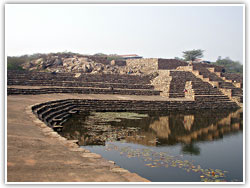|
|
Excursion from Delhi
.............................................................................................................................................................................. |
|
|
|
Surajkund
Just 20 km from Delhi’s city centre, between the
villages of Baharpur and Lakkarpur in the state of
Haryana, lies Surajkund – a village that subsists
on grazing livestock and stone quarrying.
Surajkund (Sun Pool) is a perennial lake
surrounded by rock cut steps. This place was built
by the Rajput king Surajpal Tomar, and according
to tradition this is where the Rajputs first
settled before Anangpal Tomar built Lal Kot in
Delhi in the 11th century AD. The name itself is
taken from a splendid water |
 |
|
|
tank
that is believed to have been constructed by the
Rajput king Suraj Pal in the 11th century. Another
historical reference in 1876 placed it between the
villages of Baharpur and Lakkarpur. At the head of the
reservoir, to the east, are the ruins of what is
believed to have been a sun temple. A little south is
Siddha Kund, a pool of fresh water trickling from a rock
crevice. This is said to have healing properties. About
2 km west is the Anangpur dam, made by depositing local
quartzite rocks across the mouth of a narrow ravine. The
whole area has become something of a picnic spot for
Delhi-ites. On arrival at Surajkund, one will see the
impressive dimensions of the tank blending attractively
with the rocky terrain. The local community is small,
making a living out of grazing their livestock or the
stone quarries nearby that feed building and
construction work in the city. The annual Surajkund
Crafts Mela or the fair is held between the 1st and the
15th of February every year in the village complex. This
fortnight long gathering of crafts persons from all over
India has become one of the most prominent cultural
fairs in the tourism calendar. Attractively organized on
the periphery of the water tank, the Mela brings
together potters, embroiderers, weavers, printers, wood
carvers, metal workers, stonesmiths, painters and other
craftsmen who have achieved distinction in traditional
skills, across the length and breadth of the country. In
addition, folk singers, dancers, magicians and acrobats
perform for the crowds. It is a unique opportunity to
see the traditional handicrafts being produced, where
you can also buy direct from the craftsmen, as well as
sample village food in a rural atmosphere, served on
banana leaves and in clay pots. |
|
|
|
Sultanpur Jheel
Sultanpur Jheel is a small wildlife sanctuary 46 km from
Delhi and just beyond Gurgaon. There are a number of
birds here, including flamingos. The best time to visit
this place is from November to February, the reason
being that it too attracts northern migratory birds. A
jheel is a shallow expansive lake. Reeds and other
waterside plants grow round the rim and there are some
small mud-spits in the water. Sarus cranes, the only
indigenous Indian crane, breed in the reed beds. The
migratory demoiselle is found here in large numbers over
the winter, coming to the lakeside in huge flights late
in the evening. Sarus are large and handsome. Demoiselle
are the smallest members of the ancient crane family and
are graceful and pretty, especially in flight. The other
migratory birds are geese and ducks. The greylag,
bar-headed goose and some of the migratory duck species
that visit India are the ruddy shelduck, mallard teal,
gadwall. Coots are common as are white (rosy) pelicans,
flamingoes and a variety of waders. Of the indigenous
birds visiting Sultanpur are the grey pelican,
cormorant, painted stork, grey heron, pond heron, egret,
white ibis and the blacknecked stork.
Rewari
Rewari, about 83 km from Delhi was founded in 1000 AD by
Raja Rawat and reputedly named after his daughter. There
are the ruins of a still older town east of the ‘modern’
walls. The Rajas of Rewari were partially independent,
even under the Mughals, coined their own currency called
'Gokal Sikka' and built the mud fort of Gokalgarh near
the town. Rewari fell first to the Marathas and then to
the Jat Rajas of Bharatpur. In 1805 it came under direct
British rule. It has been a prosperous centre for the
manufacture of iron and brass vessels. To the southwest
of the town is an attractive tank with ghats built by
Tej Singh and also Jain temples.
Jahazgarh
Jahazgarh, about 20 km north of Rewari, is corruption of
Georgegarh (George’s fort) and the place was supposedly
built by George Thomas, the military adventurer in the
late 18th century. With the erosion of central authority
in the 18th century, local resources were denied by the
centre and used by local chiefs for local wars of
supremacy. The Marathas used the method of levying one
fourth of the revenue (chauth) to subjugate areas and
this process had proceeded so far by the last years of
the century in the old Punjab that any adventurer who
could gather some followers might seize a fort and
terrorize the countryside. George Thomas was one of
these. In 1801 the Marathas ousted him and, abandoning
his conquests, he retired to Berhampur which was in
British territory and, therefore, safe.
|
|